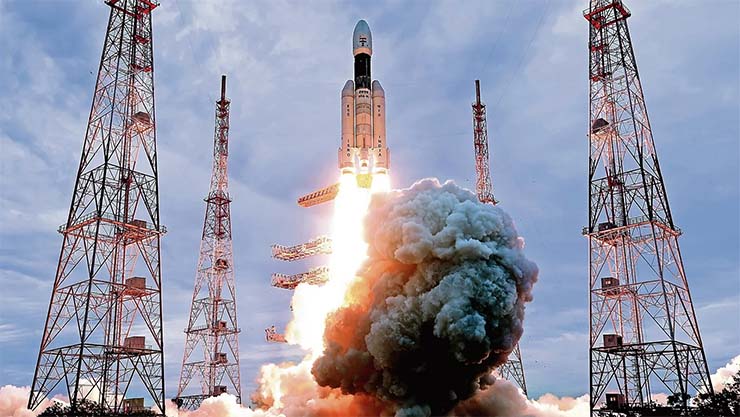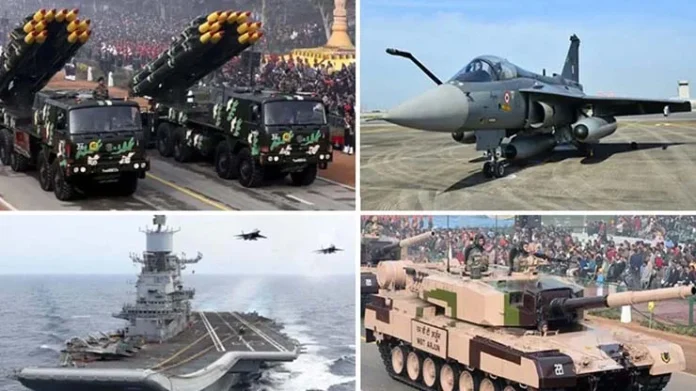Seventy-six years of independence mark a remarkable period in India’s history. A nation that has undergone dynamic economic growth, diplomatic evolution, and technological advancements now stands on the threshold of a new era—an era defined by its aspirations for self-reliance in defence.
Amidst these grand celebrations, it is also imperative to undertake a comprehensive evaluation of India’s defence preparedness. This assessment involves a multifaceted examination, encompassing military readiness, technological advancements, and indigenous defence production. The question that looms large is whether India possesses the capability to support its armed forces independently or whether gaps still exist that require attention.
In his address during the Swavlamban seminar organised by the Naval Innovation and Indigenisation Organisation (NIIO) in Gujarat in 2022, Prime Minister Narendra Modi articulated India’s commitment to self-reliance in defence. The Prime Minister emphasised the significance of this goal in the 21st century and hailed the seminar as a crucial step towards achieving it.
One of the pivotal goals he outlined is the creation of 75 indigenous defence technologies within a quarter-century—a lofty objective that has inspired the nation. However, the realisation of such an ambitious target demands unwavering dedication and concerted efforts.
Challenges on the Horizon
Despite the government’s laudable efforts to enhance self-reliance in critical sectors, challenges persist. The journey from conception to execution reveals stumbling blocks that need addressing. While initiatives are underway, a more seamless transition from policy formulation to on-ground implementation is essential.
The defence budget’s augmentation over the past eight years signifies a significant commitment. It is heartening to witness a substantial portion of defence procurement allocated to domestic manufacturers. This shift aligns with the broader goal of fostering a robust defence manufacturing ecosystem within the country.
Towards a Holistic Approach
Prime Minister Modi’s call for a “whole of the nation” approach resonates deeply in the context of defence. As India advances towards self-reliance, a unified collective consciousness serves as the bedrock of security and prosperity. The synergy between government, armed forces, and citizens assumes paramount importance in realising this vision.
Navigating Uncharted Waters
If we take a holistic view of the whole defence paradigm for India, emerging as a nascent nation and getting its whiskers wet with a war on hand within months of independence, the Indian Army has proved its mettle. But the question is, at what cost and how? Are our soldiers given the best available arms and ammunitions and backroom technological support to fight a war ranging from the naval wars to the high altitude and desert wars, all demanding different types of efficiency and tools.
Ajit K. Thakur, editor of Raksha Anirveda, opines that “India’s transformative journey to realise its self-reliance dream in defence is somewhat akin to a classic art movie narrative —characterised by deliberate pacing, a tapestry of dramatic highs and lows, and a resolute pursuit of strategic autonomy. The evolution entails calculated strategies, innovative improvisations, and a determined focus on emerging victorious.”
The Crucial Role of Self-Sufficiency
Former Army Chief, General Manoj M Naravane, emphasises the pivotal role of self-sufficiency in all aspects, stating that “Self-sufficiency in all respects, not just military hardware alone, will be the key to winning wars, through a whole of the nation effort.”
Jajati Mohanty, a Navy veteran and CEO of Schiebel India, too calls for a comprehensive approach, saying, “We need to understand this self-reliance with a whole of nation approach. Though the government is pushing for more and more indigenisation, the country’s capability to defend and attack depends on the efforts of all stakeholders.”
Mohanty highlights the need for adaptability, suggesting that armed forces may need to adjust their rules of engagement based on the capabilities provided by the industry. He stresses the importance of a conscious and pragmatic approach by the government to facilitate innovation and provide advanced weapon systems for the defence of the nation. Says he, “The government would have to take a very conscious call and be hopefully pragmatic to ensure enough push is given to the industry to innovate faster on one hand and provide cutting weapon systems to the Armed Forces for defending our nation on the other. This, I feel, would be the mantra until we ourselves become one of the leaders in the technology curve,” he emphasises.

Overcoming Historical Hurdles
Former Defence Secretary G. Mohan Kumar provides a pragmatic overview of the challenges. He points to historical factors such as lacklustre performance by defence research establishments, public sector enterprises, inadequate indigenisation, and dependence on imports. “India’s heavily bureaucratised procurement system and its preference for the public sector stunted the growth of the private sector despite the fact that the defence sector was opened to the private sector more than two decades ago. The essence of self-reliance is to have home grown technology and a vibrant defence industry ecosystem driven by innovation. India lacks both these prerequisites in major areas of defence manufacturing – fighter aircraft, submarines and land-based systems. Unless we facilitate, the deep involvement of the private sector in both defence research and manufacturing, self-reliance will remain a dream,” Kumar adds.
Evolution of Defence Policy
An examination of India’s defence policy reveals distinct phases. The initial period heavily relied on the USSR for supplies, often leading to subpar Russian arms and ammunition. The subsequent phase, post-liberalisation, witnessed a paradigm shift as India engaged with western arms manufacturers, including the UK, France, Germany, the US, and east European countries for small arms.
Commenting on this policy transition, Mohanty offers an insightful perspective: “A weapon system is as good as its capable handler, as evidenced by an old MiG-21 downing an F-16 in a recent border issue. Geopolitically restrained during the cold war era, Russia’s support allowed us to sustain our independence. The evolving geopolitical landscape now presents a new dynamic, with western powers seeking India’s alliance to maintain geopolitical equilibrium.”
Mohanty underscores the opportunity to leverage knowledge from both the Eastern Block and the Western Block. This diverse exposure equips Indian designers with varied ideas and thought processes, fostering superior technology-based solutions tailored to Indian forces.
A Realistic Assessment of Imports
G. Mohan Kumar provides a sobering perspective on India’s import dependency. Despite a 37% decline in imports from Russia between 2013 and 2021, India’s overall reliance on defence imports persists. The SIPRI-2023 report reinforces this, ranking India as the world’s largest arms importer with an 11% share of global imports.
The DefExpo held last year exposed the pressing need for India to enhance its self-reliance in the defence sector. Despite India’s progress towards becoming a $5-trillion economy, it is clear that the nation still grapples with various national security inadequacies.
The high dependency index on foreign suppliers for major military inventory items is stark. This induces a macro national vulnerability and dilutes India’s quest for meaningful and credible strategic autonomy. Furthermore, the current gaps in combat capacity expose the chinks in the Indian ability to safeguard core national security interests.
Commenting on this, G. Mohan Kumar states, “One of the reasons for the surge in Indian exports could be the substantial offset obligations resulting from the Rafale deal, amounting to nearly Rs 30,000 crore. However, with the completion of Rafale aircraft deliveries, the pace of exports may decelerate. Exporting materials involving low-end technologies, which many Indian private sector companies might be engaged in, differs from exporting high-end technology products. Due to limitations in technology development, India may not achieve dominance in the global value chain. This can only happen if major platforms are manufactured within India, alongside the creation of a requisite MSME ecosystem.”
Streamlining Processes
Former Army Chief Gen. Naravane emphasises, “Revitalising the defence industry necessitates streamlining processes and directing them towards outcomes.”
Jajati Mohanty offers another perspective, stating, “The Indian Government must adopt a top-down approach in this regard, as we missed the technology revolution. It is futile to attempt catching up with countries that have already surged ahead. Our focus should be on comprehending the nuances of AIT (Assembly Integration & Testing) to become versatile aggregators/integrators capable of producing systems and platforms. This would equip us with the knowledge and experience to then concentrate on niche technologies essential for self-reliance, rather than pursuing all types of manufacturing readily available in the global economy.”
Meanwhile, the government has set an ambitious defence export target of $5 billion (Rs 40,000 crore) by 2025. Achieving this goal demands a resolute mission-mode approach. While India’s defence exports have grown eightfold over the last five years, and the nation currently exports defence materials and equipment to over 75 countries, the 2021-22 defence export target reached only $1.59 billion (approximately Rs 13,000 crore).
Analysing how the Indian defence sector could bridge a shortfall of around $3.5 billion in the next two years, Jajati Mohanty remarks, “This is inevitable given the influx of manufacturing technologies in India, ranging from metallurgy to electronics to semi-conductors. The industry and the government are progressing swiftly across all fronts. It’s a matter of time before India becomes a significant global player in defence manufacturing.”
Former Defence Secretary G. Mohan Kumar contends, “Following independence, India’s defence production was dominated by the public sector, but its performance fell short. None of the DPSUs possessed a credible, world-class R&D system. India struggled to attract foreign talent for aircraft design and other high-tech domains. Despite remarkable strides in developing nuclear missiles, India’s overall performance in missile technology remained underwhelming. The private sector was excluded from defence manufacturing until the turn of the century, and even today, they do not operate on a level playing field. The public sector maintains dominance, securing most high-value orders from the defence ministry. India must outsource a significant portion of its R&D to the private sector to achieve breakthroughs in cutting-edge technologies.”
Global Challenges and the Path Forward
Summing up the discussion, Ajit K Thakur states, “As of now, India’s progress toward self-sufficiency in defence has been moderate. The primary hurdle lies in the lack of synchronised and seamless execution of the four Cs – continuity, commitment, consensus, and a collaborative approach. Additionally, factors such as accountability and excessive political dependence compound the challenge. It’s imperative to establish a reliable mechanism ensuring that policy decisions related to defence and national security proceed unhindered, regardless of changes in leadership. However, I advocate for provisions that allow for enhancement and refinement to maximise the benefits of these decisions.”
Overall, unforeseen exigencies, such as the Russian invasion of Ukraine, alongside other factors like the Covid pandemic disrupting the global economy and supply chains, coupled with a weakening rupee, further amplify the global challenges for India and its defence manufacturing ecosystem. It is a stark reality that India missed the industrial design and manufacturing wave, a national competency showcased by countries like South Korea and China over the past five decades. India is yet to establish a profile deemed significant and achieve complete self-reliance in defence production.
As India charts its path towards Aatmanirbharta in defence, the journey embodies an intricate interplay of vision, opportunities, and challenges. The pursuit of self-reliance remains a complex but crucial goal—an endeavour that not only secures the nation but also defines its role on the global stage.
Raksha Anirveda's editorial desk team brings in the collective experience of creative professionals - a fine mix of senior copy editors, writers, proofreaders and designers. Working as a team, they continuously create, manage, and curate content to sustain the magazine's profile and reputation in line with market trends and achieve magazine's goal.





